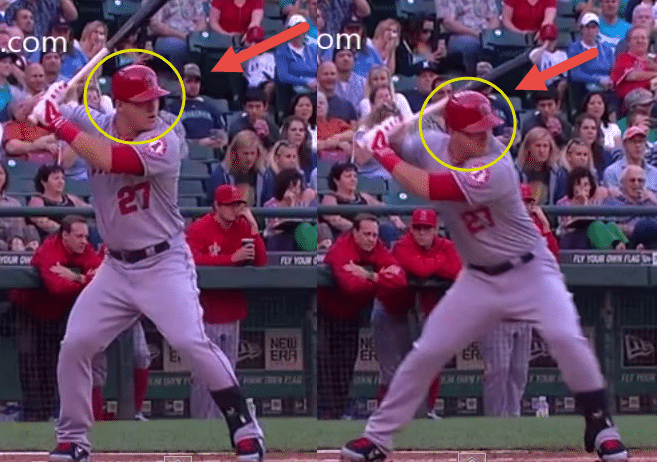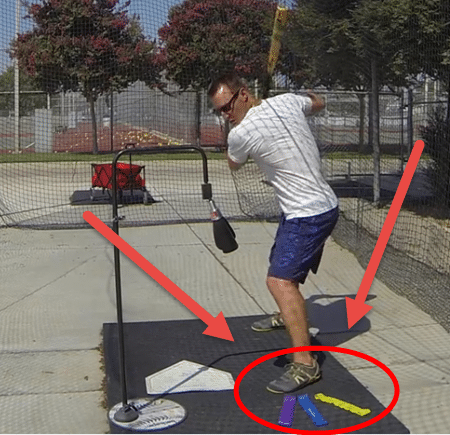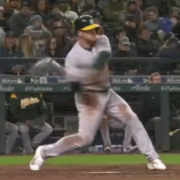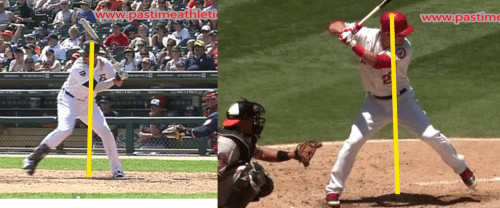Matt Chapman Swing Analysis: Metrics, Shifting Foot Pressure, OK Head Movement, & When Barrel Enters Zone Matters…
Hey, what’s going on it’s Joey Myers from the Hitting Performance Lab. In this Matt Chapman swing analysis video post, we’re going to go over a few different things…

Matt Chapman swing analysis photo courtesy: MLB.com
- We’re going to look at Matt Chapman in FanGraphs – put a little context to him,
- Talk about shifting foot pressure,
- Forward momentum and whether head movement is OK,
- Getting shorter and staying shorter,
- And then we are going to end with Barrel Path – being on time versus out in front.
Let’s get started…
Part of this Matt Chapman swing analysis is looking at the context of his numbers and metrics.He’s about six-foot two hundred and twenty pounds. In 2019, he had 36 homers, 36 doubles, hit about .249 the year before. Hit .278 with 24 homers and 42 doubles.
A little moderate on the strikeout versus his walk ratio. It looks a little bit more like a three to one type ratio. And if we look at his batted ball totals, 15.5 percent line drive rate in 2019, the league average is 20 percent. So that’s a little bit below average.
His ground ball percentage, 41.5, League average is about 43 percent. So he’s right about league average there.
But you can see here in his fly ball percentage 43.1 Percent, he’s well above average there, average is 37 percent. So definitely something there, to get the ball out of the air a little bit and more on the line drive level.
His home run to fly ball ratio is 19 percent. So it’s actually pretty good. Well above average at 9.5 percent as the league average.
Matt Chapman Swing Analysis: Shifting Foot Pressure
All right. Let’s take a look at shifting foot pressure in this Matt Chapman swing analysis, but before we get there…
I want to give context to a couple of the pitches. We’re going to look at three different at bats on three different nights. And with this pitch here from Bartolo Colon, you’re going to see it’s a way out or third. And the pitch speed is about 89-mph, possibly some sort of slider, maybe, that he keeps on the outside corner.
The plate over here, we can see that it’s still outer third, maybe a little bit closer to the middle than the pitch before. 84-mph, probably some sort of change up or slider.
Let’s take a look at the swing here on the left first. We’re looking for shifting foot pressure. And what we want to see up until stride landing, is we want to see foot pressure on the outside of the front one, we want inside of the front one.
And then what we’re going to see is, we’re going to see that switch and over here on this swing, you can see that that toe almost picks up a little bit as he’s transitioning from the outside to the inside. Here you can see the switch happening, swing and transfer.
Now we’re going to switch to inside of the back foot, outside of the front foot. And you can see on the back big toe on that big toe knuckle back here that he is staying on that back big toe knuckle to keep that foot pressure.
And then you see the front foot on the outside portion of the foot. Now, this swing over here, you’re going to see a similar thing happen where he’s going to be more foot pressure on the outside, inside of the front foot as that front foot approaches the ground. You’re going to see this shift happen where you might see the bottom of the foot, slightly. Where it kind of peels off where the pressure transfers from inside to outside.
This time, instead of the back big toe knuckle, you’re seeing it more to the inside of the back, big toe. The third swing in this Matt Chapman swing analysis was located down and in 85-mph. Maybe a cutter or slider down and in.
And you’re seeing the same type of foot pressure where it starts outside the back foot, inside the front foot, till about right here. And then we start to see it shift over and the sides reverse. So, we go inside the back foot, outside the front foot.
A little too much focus is being put with coaches, nowadays, on this back knee, and trying to keep it inside the back foot, where I think an easier solution would be to work foot pressure with hitters.
And this is something that they can just do in the room. They don’t have to hit off of a tee. But I’ve seen hitters that over rotate their lower half, young ones, almost miraculously start looking like Matt Chapman with his shifting foot pressure … when they start doing the shifting foot pressure.
Forward Momentum – Is Head Movement Okay?
Now let’s talk about forward momentum and head movement. A lot of coaches out there don’t like to see head movement at all. In this Matt Chapman swing analysis, you’re going to see that him, much like many others, have head movement. Head goes forward and down. Some just go forward.
What we should see is this forward and down or just forward. Let’s take a look here on the left. You’re going to see the head move from the top back circle to the bottom forward circle.
And then the other important note here is that at landing, the head stops moving, and should stay within that circle there. A lot of times with younger hitters, we see their head move outside of this circle. It keeps moving as they start their turn. We do not want head movement during that turn itself. But all the way from the start of the swing to stride landing, head movement is OK.
Over here in the same, different swing, you’re going to see the same head just shift and stay within that bottom ring. But we see the head move from up and back to down and forward. And then just stay within that circle through the turn itself.
Here’s the other swing on the right. You’re going to see again head starts in the up back circle, and it’s going to end up in the forward down circle. And then from there during the turn, you’re going to stay in the middle of that circle.
Head movement is OK until stride foot landing, and then the head must stay between that circle.
Getting Shorter, Staying Shorter
Let’s talk about getting shorter and staying shorter. A lot of coaches out there will teach their hitters to stay tall or to get tall. The problem is, is we don’t see that in elite hitters. We see them getting shorter, staying shorter.
You take the top 50 hitters in the big leagues, the top 100, they’re all going to get shorter and stay shorter. They’re going to create space between their feet. This helps them to control their verticals or their launch angles or attack angles, however you want to think about it. They’re just numbers, they’re just metrics, that we can measure and compare hitters.
But you can see on the left, you can see in this Matt Chapman swing analysis, him drop below that second line and he’s going to stay below that second line.
Getting shorter and then staying shorter over here on the right, you can see the same thing, different swing on a different day. But it’s still the same swing, get shorter and staying shorter.
And the third swing here on the right. You’re going to see him start tall. He will get shorter and then he will stay shorter.
And you saw the difference in those pitches – the first two I showed. Now, these aren’t as synched up as that. But when we first showed, the first two pitches were more away. The last pitch was more down and in.
FREE Catapult Loading System Book
HOT Giveaway: Signed print copy of our Amazon Bestselling book: "The Catapult Loading System: How To Teach 100-Pound Hitters To Consistently Drive The Ball 300-Feet"
Click the Button Below To See How You Can Win...
YES! I want to try my luck
Barrel Path – Being On-Time versus Being Out-In-Front
OK. In this Matt Chapman swing analysis let’s talk about barrel path, on time vs. being out in front.
Now, typically, if a hitter is on time, we use the different catcher’s gloves. You can see over here is a better example. You can see where the real catcher’s glove is over here. So, we say, imagine you got the real catcher’s glove. You have to imagine a catcher’s glove off the back foot, still where the catchers at, but in line at the back foot.
And then we get a catcher’s glove that’s in line with the hitter’s belly button. Now an on-time hitter…
Outer third part of the plate wants to knock or is what we see…we want to knock this real catcher’s glove off and hit the ball deeper than the stride foot.
If the ball’s middle third, we want to knock off the back-foot catcher’s glove, if there is a catcher’s glove in line with the hitter’s back foot. In line with the straight foot as the impact point.
And if the ball is inner third, we want to knock off the belly button catcher’s glove – to hit the ball more out in front of the front foot. When the barrel enters the zone matters. And the best do this. They aren’t perfect. They tend to stay between. They usually never will go across.
For instance, if the ball is inner third part of the plate, they’re not going to knock this deep catcher’s glove off or do a deep barrel dump, and still be able to hit this pitch out in front of their front foot as an inside pitch.
The same is true in reverse. You’re not going to see them knock the bellybutton catcher’s glove off and hit a ball deeper because a barrel is not in the zone very long. So, can either be barrel in the zone too long, which is a fact, or not long enough.
We generally see them stay between the two. If the ball is middle third of the plate right down central…. sometimes we see them knock the real catcher’s glove off, but they end up hitting it more inside the sweet spot and still can hit it pretty well. I’ve seen home runs it that way.
Or in reverse…it could be, to where maybe they are a little short. Maybe it’s middle of the plate and they’re a little shorter here because they’re trying to catch up. They’re thinking maybe fastball and they end up being a little bit more on front.
So that being said, that is on time. That is optimized. Now, this view over here is a little bit angled than this one. This one’s straighter on, but he’s out in front of all these, for the most part, you can tell just from the swing itself. You can see where he makes contact…
This first one was away, was outer third was the probably the farthest away. And he’s making contact quite a bit out in front. Again, this camera angle’s a little bit skewed, but you can see just by his body how he’s a little bit more out in front of this.
Look at his barrel path. Look where the catcher’s glove is. Again, if we were more side angle, chest view, this catcher’s glove might be more in line at the back foot. I don’t think the catch will be dumb enough to be that close. I think it’s just the angle is causing that to look that way.
But you can see Alex Rodriguez, Pujols, Mike Trout, all of them would be super proud with this “swinging down” type of demonstration. This is actually happening in a game. You can see that the barrel staying above the hands a lot longer … till about right here, it levels off or slightly dips and then you get here because he’s catching this ball a little bit out in front. And he’s cutting the corner with his barrel path.
He’s not starting it back here, and then getting it to here to have a really long barrel path, like some coaches teach, he’s actually cutting the corner in order to get to this ball more effectively. This is OK.
Over here, this was the last swing if you can remember, and this was the one that was down and in. You’re going to see a similar path again … down, middle down, middle away. You want to have a deeper barrel path. But he’s a little bit out in front. He’s going to cut the corner. You can see the barrel appear blurred.
About here, you still see the white of his batting gloves and you can see everything kind of blurring up this way. Barrel above his hands here and then he’s letting it go. A little bit more out in front, but both of these swings are almost more of hitting the belly button catcher’s glove like we just talked about, even though, this one over here was away.
This one is down, which is the middle away versus middle down. We’re going to take similar barrel paths, but we’re going to be deeper. When they’re out in front, you’ll see them cut the corner.
This swing was a little bit more over the middle of the plate, but still middle away. You can see where the catcher’s gloves at. It’s well behind him. You’re going to see this is a little longer swing. He’s going to cast it back, almost hitting the back-foot catcher’s glove. A little bit more optimized on this swing, hitting it a little bit deeper, as you can see. You can see the blur of the ball and the blur the bat kind of meeting at one.
He’s hit this one about where he should be hitting it. Optimizing. Again, he probably could have been a little bit deeper and maybe he hit this one, I think, to straightaway center instead of right center field.
He could have been a little bit more optimized by going back here, but this is imperfect, timing is imperfect. And as long as our hitters are between two close catchers’ gloves there was the real one in the back foot or the back foot in the front, the belly button one, as long as they’re between there somewhere.
We we say there’s three different barrel paths optimizing three different parts of the plate, but we cut it up into two. We say middle in and middle away … middle up, middle down. And then we just allow our hitters to … if it’s middle down, middle away, then we want to be between these two catcher’s gloves back here.
If it’s middle in or middle up, then we want to be between the back foot and belly button catcher’s gloves.
Remember, in this Matt Chapman swing analysis video post, we went over a few things…
- We looked at Matt Chapman in FanGraphs,
- Talked about shifting foot pressure,
- Forward momentum and whether head movement is OK,
- Getting shorter and staying shorter,
- And then we finished with Barrel Path – being on time versus out in front.
I hope you like this Matt Chapman swing analysis video post. Make sure that you’re swinging smarter by moving better, like our YouTube channel, like this video, share on Facebook, Twitter.
And before I let you go, I got something for you…
FREE Catapult Loading System Book
HOT Giveaway: Signed print copy of our Amazon Bestselling book: "The Catapult Loading System: How To Teach 100-Pound Hitters To Consistently Drive The Ball 300-Feet"
Click the Button Below To See How You Can Win...
YES! I want to try my luck














